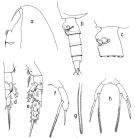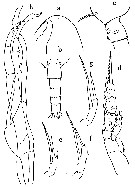|
|
 |
|
Calanoida ( Order ) |
|
|
|
Clausocalanoidea ( Superfamily ) |
|
|
|
Scolecitrichidae ( Family ) |
|
|
|
Scaphocalanus ( Genus ) |
|
|
| |
Scaphocalanus elongatus A. Scott, 1909 (F,M) | |
| | | | | | | Ref.: | | | A. Scott, 1909 (p.98, Descr.F, figs.F); Sewell, 1929 (p.205, figs.F, Rem.); C.B. Wilson, 1942 a (p.207, fig.F); Tanaka, 1961 a (p.163, figs.F,M, Rem.: p.165); Vervoort, 1965 (p.63, Rem.); Bradford, 1973 (p.144); Park, 1982 (p.77, 106, figs.F,M, Rem.); Bradford & al., 1983 (p.93); Bradford-Grieve & al., 1999 (p.881, 932, figs.F,M); Vives & Shmeleva, 2007 (p.768, figs.F,M, Rem.) |  issued from T. Park in Biology of the Antarctic Seas XI, Antarct. Res. Ser, 1982, 34. [p.107, Fig.18]. Female: a, forehead (lateral); b, last thoracic segment and urosome (lateral left side); c, genital segment (lateral); d, P1 (anterior); e, P2 (posterior); f, P5 (posterior); g, distal part of inner spine of P5; h, P5 showing variation. Nota: Urosome about 33/100 length of prosome. Ventral side posterior to genital opening bearing patches of hairs. A long digitiform extension with an irregular outline wich arises dorsally from a relatively small spermathecal sac.
|
 issued from T. Park in Biology of the Antarctic Seas XI, Antarct. Res. Ser, 1982, 34. [p.108, Fig.19]. Male: a, habitus (lateral right side; b, last thoracic segment and urosome (lateral left side); c, P1 (anterior); d, P5 (viewed from left side); idem (viewed from right side). Nota: Urosome about 56/100 length of prosome. All cephalosomal appendages as in S. antarcticus
|
 issued from : R.B.S. Sewell in Mem. Indian Mus., 1929, X. [p.206, Fig.77]. Female (from Laccadive Sea): a, habitus (lateral left side); b, Rostrum; c, A2; d, Mx1; e, Mx2; f, Mxp; g, P1; h, P2; j, P5; k, P5 abnormal. Nota: Sewell remarks that the forehead bears a linear crest.
|
 issued from : A. Scott in Siboga-Expedition, 1909, XIX a. [Plate XXXII, Figs.10-16]. Female (from Halmahera Sea): 10, habitus (dorsal); 11, forehead (lateral); 12, last thoracic and genital segments (left side); 13, rostrum; 14, Mx2 (distal portion); 15, P2; 16, P5. Nota: In A. Scott's original description of the species he states that the forhead appears narrowly rounded, and it is faintly thickened in the middle line, which mat indicate a very weak crest. He shows no crest in his figure.
|
 issued from : C.B. Wilson in Scientific Results of Cruise VII of the Carnegie during 1928-1929. Biology-I. Carnegie Inst. Wash. Publ. 536, 1942. [p.231, Fig.113]. Female (from W tropical Pacific): 113, P5.
|
 issued from : O. Tanaka in Publ. Seto Mar. Biol. Lab., 1961, IX (1). [p.164, Fig.115]. Female (Japan: Sagami Bay): a, forehead (lateral); b, last thoracic segment and urosome (dorsal); c, last thoracic segment and genital segment (lateral, left side); d, P2; e, P5; f, idem (other specimen). Nota: Cephalothorax and abdomen in proportional lengths 76 : 24. Last thoracic segment produced triangulary with a slight projection at the apex. Urosome 4-segmented; urosomal segments and caudal rami in proportional lengths 31 : 21 : 20 : 8 : 20 = 100. Genital segment not produced below, but concave at the genital area, there is a patch of fine hairs on the posterior periphery of the genital opening; distal border of the segment finely striated with teeth ; 2nd and 3rd segments also striated on the distal border. Caudal rami 2.5 times as long as wide. 1st segment of A1 with a row of fine spinules on the posterior distal border. Terminal spine of exopod of P2 with 21 teeth. P5 2-segmented, terminal segment with 3 spines, 1 on each margin and 1 on the apex. (in some specimen the segment has only 2 spines, 1 on the inner margin and 1 on the apex; another specimen had 4 spines of which two on the outer margin are very small. Male: h, P5. Nota: Cephalothorax and abdomen in proportional lengths 63 : 37 or 64 :3 6. Last thoracic segment with lateral margin rounded. Urosome 5-segmented, urosomal segments and caudal rami in proportional lengths 6 : 36 : 22 : 26 : 2 : 8 = 100. 4th urosomal segment 2 times as long as it is wide at the proximal (28 : 14), and is slightly inflated towards the distal margin. Anal segment very short, concealed beneath the foregoing (in dorsal view). Caudal rami divergent, 1.5 times as long as wide. A1 extends at least to the end of the 3rd thoracic segment; left A1 with 19 segments (segments 8 to 12, and 13-14 fused, the distal segments are missing; the 1st segment has a row of spinules near the posterior distal margin. Terminal spine of exopod of P2 with about 50 serrations. P5 reaches back to the distal margin of the 2nd urosomal segment; endopod of the left leg 3-segmented, the inner margin of the endopod produced at the proximal 1/3 of the endopod where the 1st segment connects with the 2nd; endopod of the right leg is slender and long, extending about to the distal end of the 2nd basal segment of the left leg.
|
 issued from : O. Tzanaka in Publ. Seto Mar. Biol. Lab., 1961, IX (1). [p.165]. Male: Proportional lengths of the segments of A1.
| | | | | Compl. Ref.: | | | Sewell, 1948 (p.349, 540); Grice & Hulsemann, 1965 (p.224); 1967 (p.16); Furuhashi, 1966 a (p.295, vertical distribution in Oyashio/Kuroshio transitional area, Table 8, 9, 10); Park, 1970 (p.476); Roe, 1972 (p.277, tabl.1,2); Harding, 1974 (p.141, tab.2, gut contents); Deevey & Brooks, 1977 (p.256, tab.2, Station "S"); Vives, 1982 (p.292); Razouls & al., 2000 (p.343, Appendix); Kuriyama & Nishida, 2006 (p.300: Tab.II; p.309: Tab.III, fig.7, 10, vertical distribution); Park & Ferrari, 2009 (p.143, Table 4, Appendix 1, biogeography); Hidalgo & al., 2010 (p.2089, Table 2); Sano & al., 2013 (p.11, Table 9, food habits); Bonecker & a., 2014 (p.445, Table II: frequency, horizontal & vertical distributions); Dias & al., 2019 (p.1, Table II, IV, occurrrence, vertical distribution) | | | | NZ: | 11 | | |
|
Distribution map of Scaphocalanus elongatus by geographical zones
|
| | | | | | | | | | Loc: | | | Antarct. (Indian, SW Pacif.), sub-Antarct. (Indian, SW & SE Pacif.), G. of Guinea, off Morocco-Mauritania, Canary Is., Brazil (off Rio de Janeiro, The Campos Basin), Caribbean Sea, off Bermuda: Station ‘’ S’’ (32°10’N, 64°30’W), off E Cape Cod, Indian (off SW & E Sri Lanka), Halmahera Sea, Japan, off E Hawaii, S Chile | | | | N: | 21 | | | | Lg.: | | | (5) F: 2,9; (16) F: 2,7; (29) F: 2,92-2,55; (76) F: 3,2-2,76; M: 3,44-3,16; (108) F: 3,14-2,56; M: 2,86-2,55; (199) F: 2,81-2,51; M: 2,81-2,43; (1000) F: 2,9 ± 0,2; {F: 2,51-3,20; M: 2,43-3,44} | | | | Rem.: | meso-bathypelagic.
Sampling depth (Antarct., sub-Antarct.): 0-3000 m. Sargasso Sea: 500-2000 m (Deevey & Brooks, 1977, station "S"); 2000-1000 m (Harding, 1974).
Distributional range (m) from Roe (1972) Day: 720-900, Night: 720-800; from Grice & Hulsemann (1965): 1500-4000 (in Kuriyama & Nishida, 2006).
Genus not assured but probable.
For Vervoort (1965, p.63), Tanaka (1961 a, p.166) has, probably correctly, referred Brodsky's male specimens of S. brevicornis to S. elongatus. S. elongatus from Hamahera Sea, appears uncrested, though a weak line on the head seems to have been present. Additional specimens were recorded by Sewell (1929) from the Bay of Bengal, but as these specimens differ in many respects from Scott's original specimen and from those recorded by Tanaka, their identification as S. elongatus is very doubtful. The specimen from the Gulf of Guinea found by Vervoort is the first from the Atlantic Ocean.
First occurrence in Chilean waters by Hidalgo & al. (2010) | | | Last update : 19/01/2021 | |
|
|
 Any use of this site for a publication will be mentioned with the following reference : Any use of this site for a publication will be mentioned with the following reference :
Razouls C., Desreumaux N., Kouwenberg J. and de Bovée F., 2005-2025. - Biodiversity of Marine Planktonic Copepods (morphology, geographical distribution and biological data). Sorbonne University, CNRS. Available at http://copepodes.obs-banyuls.fr/en [Accessed November 30, 2025] © copyright 2005-2025 Sorbonne University, CNRS
|
|
 |
 |









